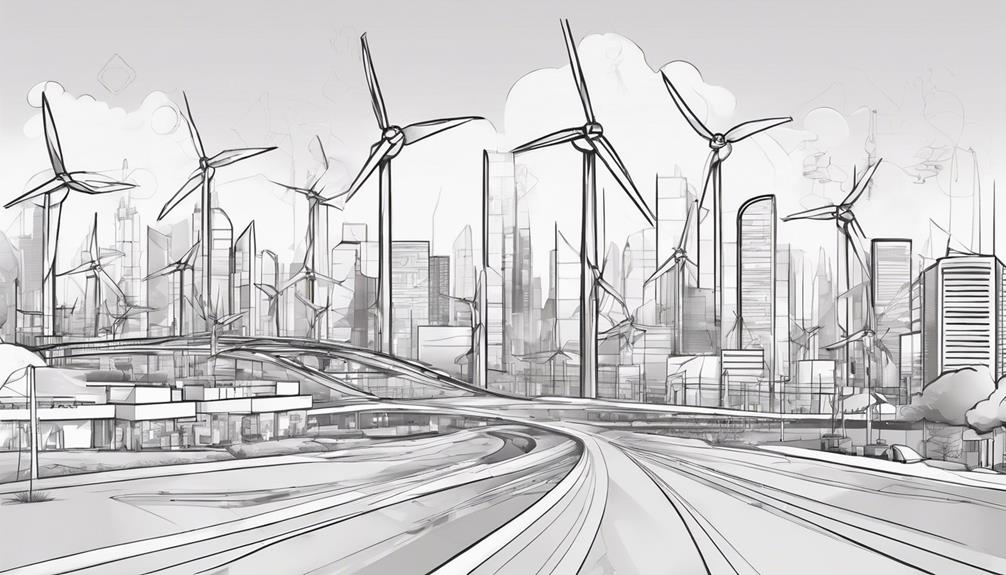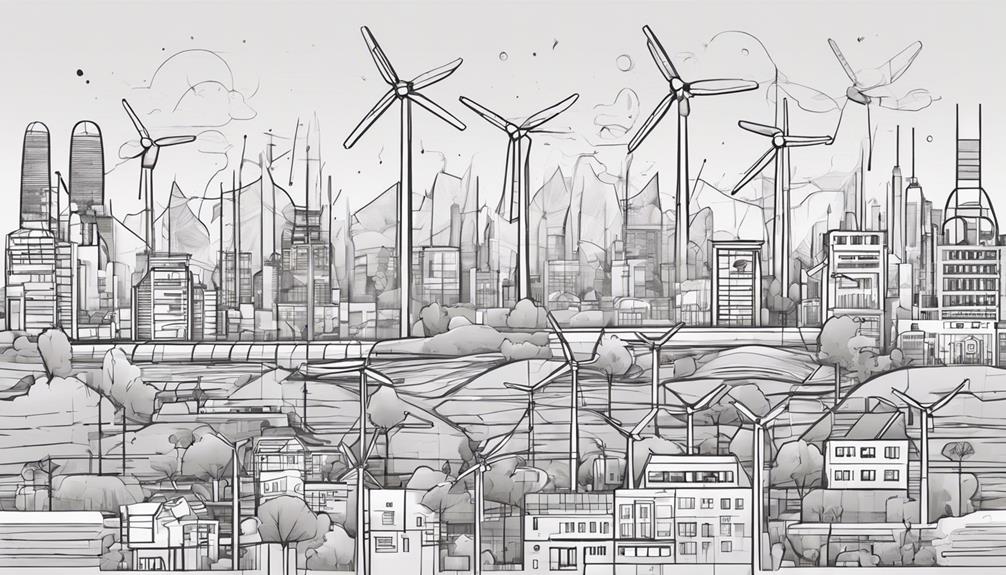Addressing the equilibrium between energy demands and environmental preservation necessitates a methodical examination of sustainable practices and their real-world implications. As society navigates this intricate interplay, questions arise regarding the feasibility and scalability of existing solutions. Can we truly strike a harmonious balance between our energy requirements and the imperative need for environmental stewardship? The intricacies of this multifaceted issue merit careful consideration and a collaborative effort from various sectors to explore viable pathways forward.
Key Takeaways
- Transitioning to renewable energy mitigates environmental impacts.
- Government policies incentivize cleaner energy adoption.
- Technology innovation reduces emissions and promotes sustainability.
- Balancing energy needs with ecological preservation is imperative.
Environmental Impacts of Energy Sources

Quantifying the environmental impacts of energy sources is essential for understanding the implications of our energy choices on climate change and ecosystem health. Fossil fuels, the predominant energy source globally, significantly contribute to greenhouse gas emissions, leading to climate change and air pollution. The extraction and combustion of fossil fuels not only release pollutants but also result in habitat destruction, negatively impacting ecosystems and wildlife.
In contrast, renewable energy sources like solar and wind power offer a more sustainable alternative, producing minimal emissions and reducing environmental harm. These technologies not only help in mitigating air emissions but also play a crucial role in reducing resource depletion and minimizing environmental consequences associated with energy production.
Transitioning to renewable energy is fundamental for achieving a balance between fulfilling energy needs and ensuring sustainable environmental practices. Embracing energy efficiency measures alongside the adoption of renewable energy technologies is imperative in mitigating the environmental impacts of energy sources and fostering a more sustainable energy future.
Strategies for Balancing Energy Needs
To achieve a harmonious equilibrium between meeting energy demands and addressing environmental considerations, strategic approaches must be implemented.
- Renewable energy sources offer a sustainable alternative to traditional fossil fuels, reducing greenhouse gas emissions and lessening environmental impacts associated with energy production.
- Government policies that incentivize the adoption of cleaner energy sources and promote responsible energy consumption are essential in achieving a balance between energy needs and environmental concerns.
- Technology and innovation play a critical role in developing cleaner energy solutions and advancing energy efficiency measures to mitigate the environmental footprint of energy consumption.
- Energy conservation efforts, such as implementing energy-efficient practices and investing in energy-saving technologies, are crucial for reducing overall energy demands and promoting sustainability in energy usage.
Role of Technology in Sustainability

In the context of balancing energy needs with environmental concerns, the role of technology in sustainability emerges as a critical factor in shaping the future of energy production and consumption. Technological advancements in energy storage have facilitated the integration of renewable energy sources into existing grids, reducing the reliance on fossil fuels and decreasing emissions. Grid integration technologies are pivotal in managing the intermittency of renewable energy, ensuring a stable and consistent power supply. Continued research and development in sustainable energy solutions are imperative for enhancing the effectiveness and efficiency of renewable technologies, promoting cleaner energy production. Innovation in energy technology holds the potential to minimize environmental impacts associated with energy production and consumption, thereby improving air quality and reducing potential risks. The table below highlights key aspects of technology's role in promoting sustainability.
| Aspect | Description | Importance |
|---|---|---|
| Energy Storage | Enhances stability of renewable sources, reduces fossil fuel dependency | High |
| Grid Integration | Manages renewable energy intermittency, ensures reliable power supply | Critical |
| Sustainable Solutions | Research and development essential for improving renewable technology effectiveness | Crucial |
| Environmental Impact | Technology innovation can reduce emissions, promote cleaner energy production | Significant |
Case Studies in Energy-Ecology Balance
An exploration of case studies exemplifying the balance between energy requirements and ecological considerations reveals crucial insights into sustainable energy practices.
- Germany's Energiewende demonstrates successful energy transition with a focus on reducing air pollution and balancing energy needs through increased solar power utilization and land use optimization.
- The impact of oil sands extraction in Alberta, Canada, emphasizes the challenge of balancing energy demands with habitat destruction and carbon footprint concerns, highlighting the necessity for sustainable energy practices.
- Wind power in Denmark showcases successes and challenges in grid integration and public acceptance, underscoring the importance of balancing energy needs with environmental impacts.
- Solar power projects in California's Mojave Desert exemplify careful site selection and environmental impact mitigation to achieve a balance between energy production and ecological preservation, showcasing the significance of smart grid implementation and energy storage solutions.
These case studies underscore the critical need to consider environmental impacts alongside energy production to achieve a harmonious balance between energy needs and ecological preservation.
Future Challenges and Solutions

Given the projected 32% increase in energy consumption over the next two decades and the need for 1,300 to 1,900 new power plants, addressing future challenges in balancing energy needs and environmental concerns becomes paramount for sustainable energy development. To navigate these challenges, a multifaceted approach involving renewable energy sources, energy conservation, government policies, and technological innovations is essential. The table below summarizes key strategies and solutions to foster a more sustainable energy future.
| Category | Solutions | Examples |
|---|---|---|
| Renewable Energy Sources | Investing in solar and wind power to reduce reliance on fossil fuels | Installation of solar panels on homes |
| Energy Conservation | Implementing energy-efficient practices in industries and households | Using LED lighting and smart thermostats |
| Government Policies | Enforcing emissions regulations and incentivizing green initiatives | Subsidies for electric vehicles |
| Technological Innovations | Advancing nuclear energy technology for cleaner power generation | Development of small modular reactors |
| Greenhouse Gas Emissions | Monitoring and reducing carbon emissions from industrial processes | Carbon capture and storage techniques |
Frequently Asked Questions
How Can We Reduce the Impact of Using Energy on the Environment?
Reducing the impact of energy use on the environment involves embracing renewable sources, promoting conservation, and implementing green technology for efficiency gains. Sustainable practices can help minimize emissions and reduce the carbon footprint of energy consumption. By prioritizing environmental impact assessments and adopting eco-friendly solutions, we can mitigate pollution, support sustainability, and combat climate change through responsible energy usage.
How Can We Save Energy in the Environment?
To save energy in the environment, focus on energy conservation through efficient appliances, sustainable practices, and green technology. Utilize renewable resources, reduce carbon footprint, and implement eco-friendly solutions. Conservation efforts like upgrading to LED bulbs, proper insulation, and setting thermostats optimally can lead to significant energy savings. Embracing these strategies not only benefits the environment but also promotes energy efficiency and cost savings in the long run.
What Is the Best Solution to Meet Energy Demands While Protecting the Environment?
To meet energy demands while protecting the environment, a comprehensive approach involving the utilization of renewable resources, implementation of sustainable solutions, adoption of green technology, enhancement of energy efficiency, promotion of environmental preservation, incorporation of eco-friendly practices, reduction of carbon footprint, and mitigation of climate change is crucial. By integrating these elements, a balanced strategy can be achieved that ensures energy requirements are met sustainably without compromising environmental well-being.
How Does Our Need for Energy Impact the Environment?
Our need for energy exerts a significant impact on the environment due to the extraction and burning of fossil fuels, leading to pollution, habitat destruction, and climate change. Transitioning to renewable resources, implementing pollution control measures, and embracing green technology can mitigate these effects. Energy efficiency, ecosystem preservation, and sustainable practices are essential for reducing our carbon footprint and safeguarding biodiversity. Conservation efforts and sustainable development are crucial for addressing the environmental impact of our energy consumption.
Conclusion
In conclusion, balancing energy needs with environmental concerns is a complex challenge that requires a strategic approach. By transitioning towards renewable energy sources, implementing energy conservation measures, and leveraging technological advancements, we can minimize environmental impacts and ensure a sustainable energy future. It is imperative to prioritize sustainability, engage in ongoing research and development, and collaborate with stakeholders to address the growing energy demands while safeguarding the environment for future generations.
